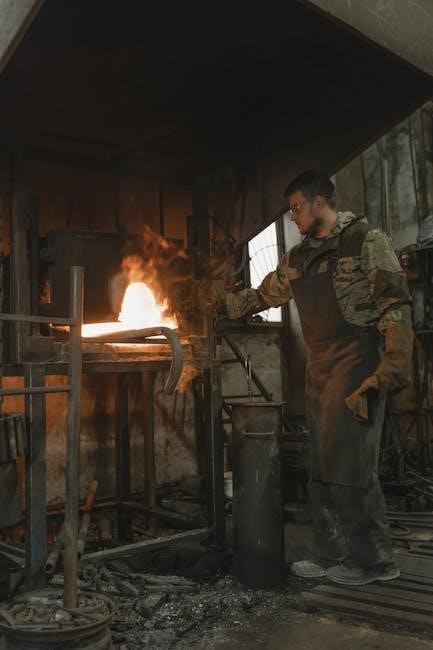Neutral Safety Switch in Manual Transmissions: An Overview
The neutral safety switch (NSS)‚ crucial for safety‚ typically resides on the transmission case. It’s activated‚ preventing starts unless in neutral. Manual transmissions often employ a similar clutch safety switch. The NSS allows electrical current flow for ignition when engaged properly.
Purpose of the Neutral Safety Switch (NSS)
The primary purpose of the Neutral Safety Switch (NSS) in a manual transmission vehicle is to enhance safety by preventing accidental starts. Imagine a scenario where a vehicle is left in gear. Without an NSS‚ turning the ignition key could cause the vehicle to lurch forward‚ potentially leading to accidents or damage. The NSS acts as a safeguard‚ ensuring that the engine can only be started when the clutch pedal is fully depressed‚ disconnecting the engine from the transmission. This mechanism ensures that the vehicle cannot move unexpectedly during startup.

Specifically‚ the NSS‚ or a similar clutch safety switch‚ interrupts the starter circuit unless the clutch is engaged. This interruption prevents the starter motor from cranking the engine if the transmission is still connected. This function is especially important in preventing accidents in confined spaces like garages or parking lots. Furthermore‚ the NSS acts as a safety net‚ protecting both the driver and any nearby pedestrians or objects from potential harm. By strictly controlling when the engine can start‚ the NSS significantly reduces the risk of unintended vehicle movement.
Location of the NSS in Manual Transmissions
The Neutral Safety Switch (NSS) in manual transmissions typically isn’t found directly on the transmission case like it is in automatic transmissions. Instead‚ a similar switch‚ often referred to as the clutch safety switch or clutch start switch‚ serves the same purpose. This switch is generally located near the clutch pedal assembly inside the vehicle’s cabin. Its precise location can vary depending on the vehicle’s make and model‚ but it is usually mounted either on the pedal bracket or near the top of the clutch pedal’s travel.

To locate the clutch safety switch‚ one should look for a small electrical component connected to the clutch pedal mechanism. It often has wires leading to it‚ indicating its connection to the vehicle’s electrical system. The switch is positioned so that it is activated (or deactivated) when the clutch pedal is fully depressed. Accessing the switch usually requires removing the lower dashboard panel or maneuvering within the driver’s footwell. Consulting a vehicle-specific repair manual or diagram can provide precise instructions for locating the clutch safety switch.
How the NSS Works in Manual Transmissions
In manual transmissions‚ the neutral safety switch function is typically handled by a clutch safety switch. This switch operates as a crucial safety mechanism‚ preventing the engine from starting unless the clutch pedal is fully depressed. When the driver presses the clutch pedal‚ it activates the clutch safety switch‚ completing an electrical circuit. This completed circuit allows the starter motor to engage‚ enabling the engine to crank and start.
Conversely‚ if the clutch pedal is not depressed‚ the clutch safety switch remains open‚ breaking the electrical circuit to the starter motor. This prevents the engine from starting‚ even if the ignition key is turned. This system ensures that the vehicle cannot inadvertently lurch forward upon starting if left in gear. The switch is designed for simple on/off functionality‚ directly tied to the clutch pedal’s position. Some systems also integrate this switch with cruise control deactivation.
Symptoms of a Failing NSS in Manual Transmissions
When the neutral safety switch (or more accurately‚ the clutch safety switch in a manual transmission) begins to fail‚ several symptoms can manifest. One of the most common signs is the inability to start the vehicle‚ even when the clutch pedal is fully depressed. This occurs because the faulty switch fails to complete the electrical circuit required for the starter motor to engage. Intermittent starting problems can also arise‚ where the vehicle starts sometimes but not others‚ indicating a weakening connection within the switch.

Another symptom includes the engine starting without depressing the clutch pedal‚ a clear indication that the switch is malfunctioning and no longer providing the necessary safety interlock. This is a dangerous situation‚ as the vehicle could unexpectedly move if left in gear. Conversely‚ the cruise control might not engage or disengage properly if the switch is also tied to the cruise control system. Finally‚ unusual electrical issues‚ such as flickering lights or a malfunctioning starter‚ could be indirectly related to a failing NSS‚ though these are less common.
Clutch Safety Switch: A Similar Function
In manual transmission vehicles‚ the clutch safety switch serves a function analogous to the neutral safety switch in automatics. While the neutral safety switch prevents starting unless the automatic transmission is in Park or Neutral‚ the clutch safety switch ensures the manual transmission vehicle starts only when the clutch pedal is depressed.
Located near the clutch pedal linkage‚ this switch interrupts the starter circuit unless activated by pressing the clutch. This prevents accidental starts while the vehicle is in gear‚ mitigating the risk of sudden‚ unintended movement. Depressing the clutch disengages the transmission from the engine‚ providing a safe starting condition. Without a functional clutch safety switch‚ a vehicle left in gear could lurch forward upon ignition‚ potentially causing damage or injury. Therefore‚ the clutch safety switch is a critical safety component in manual transmission vehicles‚ replicating the protective function of the neutral safety switch.
Vehicles Without a NSS in Manual Transmissions

While the neutral safety switch or a clutch safety switch is a common safety feature in modern vehicles‚ some older models‚ particularly certain trucks with manual transmissions‚ may not be equipped with either. This means the vehicle can potentially be started regardless of whether it’s in gear or the clutch is depressed. This absence places a greater emphasis on the driver’s responsibility to ensure the vehicle is in neutral before starting.

For example‚ some older Ford light-duty trucks with manual transmissions lacked any neutral safety switch mechanism. In these vehicles‚ simply turning the key would engage the starter‚ irrespective of gear selection. This design choice necessitates heightened driver awareness to prevent unintended vehicle movement upon ignition. Drivers of these vehicles must consciously verify the gear lever is in neutral and exercise extreme caution when starting the engine.
Troubleshooting P0850 and P0507 Codes
When diagnosing issues related to starting or idle speed‚ specifically in vehicles with manual transmissions‚ codes P0850 and P0507 might surface. P0850 typically indicates a problem within the neutral safety switch circuit. This could stem from a faulty switch‚ damaged wiring‚ or a loose connection. Begin by visually inspecting the wiring and connections to the neutral safety switch‚ ensuring they are secure and free from corrosion.
P0507‚ on the other hand‚ relates to an idle air control system issue where the engine idle speed is higher than expected. While seemingly unrelated‚ a malfunctioning neutral safety switch can sometimes indirectly influence idle speed. After addressing any P0850 concerns‚ cleaning the throttle body and inspecting the idle air control valve are prudent steps. A thorough diagnosis often requires a multimeter to test the continuity of the NSS and the voltage signals to the IAC valve.
NSS and Vehicle Inspections
During vehicle inspections‚ particularly in states with stringent safety regulations like Virginia‚ the functionality of the neutral safety switch (NSS) is often assessed. Inspectors verify that the vehicle starts only when the clutch pedal is fully depressed in manual transmissions or when the gear selector is in Park or Neutral in automatic transmissions. A malfunctioning NSS can lead to inspection failure‚ requiring immediate attention.
The inspection process typically involves a visual examination of the switch and its wiring‚ ensuring it’s properly connected and free from damage. Additionally‚ the inspector will start the vehicle in various gear positions (or with the clutch engaged and disengaged) to confirm the NSS is functioning correctly. Failure to meet these standards necessitates repair or replacement of the switch before the vehicle can pass inspection. This ensures a baseline level of safety for all vehicles on the road.
Cost of Replacing NSS

The cost of replacing a neutral safety switch (NSS) can vary significantly depending on several factors‚ including the vehicle’s make and model‚ the type of transmission (manual or automatic)‚ and the labor rates in your geographic location. Generally‚ for a manual transmission vehicle‚ the cost may range from AED 100 to AED 270 in the UAE. However‚ this is just an example‚ and prices vary from place to place.
Parts costs can range from inexpensive aftermarket options to more expensive OEM (Original Equipment Manufacturer) components. Labor costs will depend on the complexity of the job and the shop’s hourly rate. Some vehicles may require more extensive disassembly to access the NSS‚ increasing labor time. Obtaining quotes from multiple mechanics is advisable to ensure a fair price. Remember to factor in potential diagnostic fees if the shop needs to confirm the NSS is indeed the problem. Always prioritize quality parts and experienced technicians for a reliable repair.

Safety Implications of a Faulty NSS

A faulty neutral safety switch (NSS) presents significant safety risks‚ especially in vehicles with manual transmissions. The primary function of the NSS‚ or a similar clutch safety switch‚ is to prevent the engine from starting unless the clutch pedal is fully depressed. When this switch fails‚ the vehicle could potentially start in gear‚ leading to sudden and unexpected movement.

Imagine a scenario where the car is parked‚ and the driver attempts to start the engine without fully depressing the clutch. If the NSS is malfunctioning‚ the engine could start while the transmission is still engaged‚ causing the vehicle to lurch forward or backward. This could result in property damage‚ personal injury‚ or even a collision. Furthermore‚ a faulty NSS might allow the car to start in neutral without needing the clutch‚ creating a dangerous situation if the driver is unprepared for the sudden engine engagement. Regular inspection and timely replacement of a failing NSS are crucial for maintaining vehicle and driver safety‚ preventing hazardous unintended movements.
